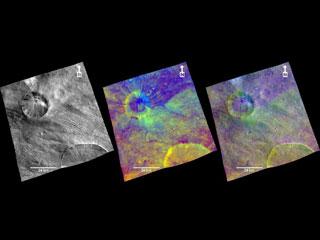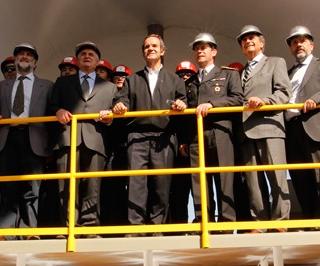
These composite images from the framing camera aboard NASA's Dawn spacecraft show three views of a terrain with ridges and grooves near Aquilia crater in the southern hemisphere of the giant asteroid Vesta. Photo: NASA/JPL-Caltech/UCLA/MPS/DLR/IDA.
PASADENA, CALIFORNIA (BNS): Findings from NASA's Dawn spacecraft reveal new details about the giant asteroid Vesta, including its varied surface composition, sharp temperature changes and clues to its internal structure.
The findings will help scientists better understand the early solar system and processes that dominated its formation.
Images from Dawn's framing camera and visible and infrared mapping spectrometer, taken 420 miles (680 kilometers) and 130 miles (210 kilometers) above the surface of the asteroid, show a variety of surface mineral and rock patterns.
"Dawn now enables us to study the variety of rock mixtures making up Vesta's surface in great detail. The images suggest an amazing variety of processes that paint Vesta's surface," Harald Hiesinger, a Dawn participating scientist at Münster University in Germany, was quoted as saying in a NASA news report.
Researchers also see breccias, which are rocks fused during impacts from space debris. At the Tarpeia crater near the south pole of the asteroid, Dawn imagery revealed bands of minerals that appear as brilliant layers on the crater's steep slopes. The exposed layering allows scientists to see farther back into the geological history of the giant asteroid.
Dawn has given scientists a near 3-D view into Vesta's internal structure. By making ultrasensitive measurements of the asteroid's gravitational tug on the spacecraft, Dawn can detect unusual densities within its outer layers, the report said.
"After more than nine months at Vesta, Dawn's suite of instruments has enabled us to peel back the layers of mystery that have surrounded this giant asteroid since humankind first saw it as just a bright spot in the night sky," Carol Raymond, Dawn deputy principal investigator at NASA's Jet Propulsion Laboratory (JPL) in Pasadena, California added.
 Previous Article
Previous Article Next Article
Next Article













The Indian Air Force, in its flight trials evaluation report submitted before the Defence Ministry l..
view articleAn insight into the Medium Multi-Role Combat Aircraft competition...
view articleSky enthusiasts can now spot the International Space Station (ISS) commanded by Indian-American astr..
view article